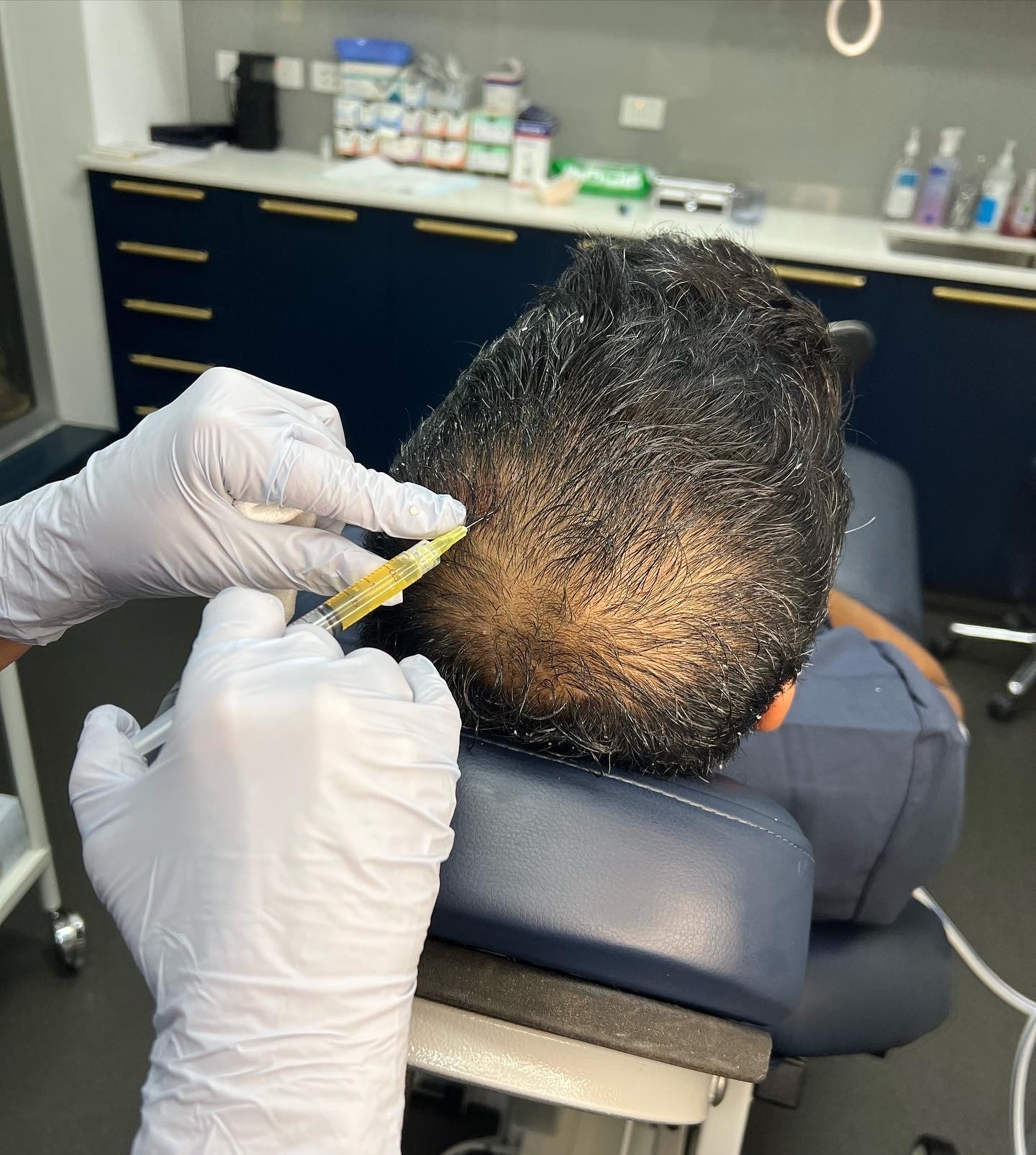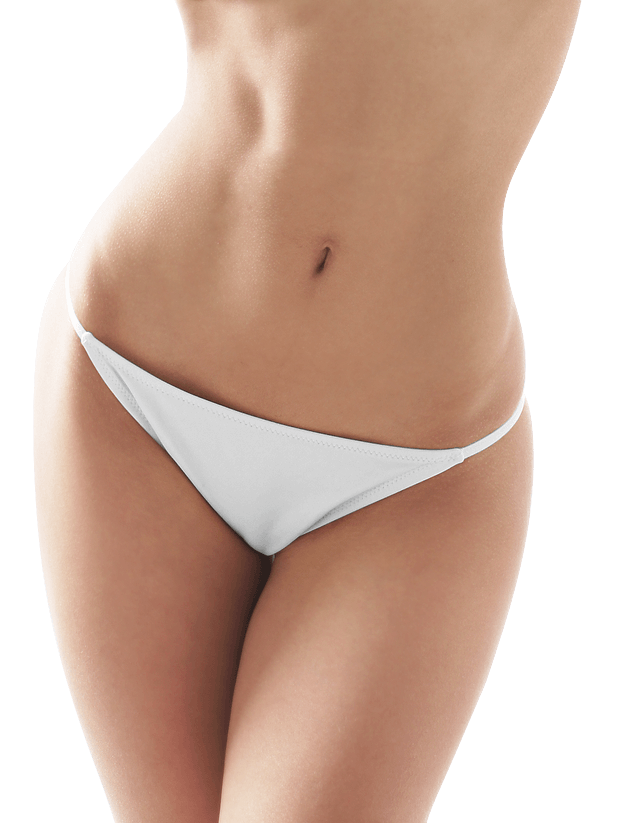What is PRP hair treatment?
Platelet Rich Plasma (PRP) injections are a popular new and non-surgical method of hair loss treatment and hair restoration for women and men. What PRP does is use your own blood supply in a way that only the enriched cells that contain various types of proteins remain. During PRP injection treatment, a standard blood draw occurs. The blood is spun in a centrifuge in which the highly concentrated PRP is separated from the other components of the blood (such as red blood cells).
This platelet-rich plasma, which contains helpful white blood cells and platelets rich in growth factors, can then be injected into areas of the scalp that are experiencing hair loss, extreme hair shedding, or thinning hair. Our nurse applies a topical anesthetic to the scalp an hour before the procedure, to minimize any minor discomfort from the injections. The procedure takes approximately 30 minutes from the time your blood is drawn until the PRP is injected into your scalp, and no downtime is required post-treatment.
What is Platelet-Rich Plasma?
Platelet-rich plasma is a concentration of platelets that is 3x the normal blood value, and contains many growth factors that stimulate hair follicles and can safely be performed up to every month, based on how much hair growth is required. PRP is a great solution for hair loss in both men and women, especially when hair transplant surgery is not an option. PRP injections can stimulate new hair growth in men who suffer from androgenetic alopecia (known as male pattern baldness) and women who suffer from female pattern baldness.
What are the benefits of PRP therapy?
The Platelets in the PRP contain proteins that are needed in order to promote the rate of tissue healing and regeneration within inactive hair follicles. Inside these platelets are a variety of intracellular structures such as glycogen (a form of glucose), lysosomes (which break down the proteins), and alpha granules (which contain clotting and growth factors that get released during the cell repair process). Platelet-rich plasma-derived growth factors can also play a part in stem cell differentiation within the wound healing process of the musculoskeletal system.
PRP is a very modern procedure that has been used elsewhere as a method of healing injuries. It is often also used as a cosmetic treatment for the face too, and of course as a popular hair procedure for men and women.
Do PRP injections work for hair loss?
In multiple studies through the Journal of Cosmetic Dermatology and Aesthetic Plastic Surgery, patients suffering from hair loss were found to benefit from PRP injections. The PRP hair restoration treatment led to a significant local increase in hair number, extended growth phase, and improved hair thickness. The science behind PRP uses proven benefits of PRP to naturally promote new cellular growth. PRP is directly involved in regenerative healing within the body. PRP growth factors can thus influence hair growth and can in fact restore hair follicles, in turn improving the look and feel of a patient’s hair.
How does PRP hair restoration work?
PRP hair rejuvenation treatment involves the injection of platelets into the area of the body in which hair loss is occurring, for example the crown of the head. Platelets are taken from the patients own body via a blood draw that occurs at the start of the appointment. After the blood has been drawn, it is placed in a centrifuge, which is a machine that separates the platelet-rich plasma from the red blood cells. When isolated, the platelet-rich plasma is then injected into the treatment area. The platelets release growth factors, which stimulates the dermal papilla cells that are crucial in the hair growth process. For that reason, a series of PRP injections help to trigger hair regrowth to restore lost hair.
How many PRP treatments are needed?
Though of course the number of PRP treatments varies depending on the hair condition and aesthetic goals of the individual patient, a typical patient will do three sessions of PRP therapy. Further treatments will be evaluated at the end of the fourth month (after the third PRP treatment).The sessions are typically spaced 4-6 weeks apart. PRP treatments can also be used in tandem with hair transplantation to help accelerate hair growth.
Does PRP hair treatment work for frontal hair loss?
In recent studies in the journals Dermatologic Surgery and International Journal of Women’s Dermatology, PRP has been indicated as an effective treatment for hair loss. This hair growth and improvement has been demonstrated with patients who experience both androgenetic alopecia and alopecia areata, which is defined as unpredictable hair loss in patches all over the scalp. Based on these significant studies, as well as those in Journal of Cosmetic Dermatology, Aesthetic Plastic Surgery, and Men’s Journal, PRP is considered an effective treatment for hair loss throughout the scalp.
How much is PRP hair treatment?
Costs vary based on your need. Typically, PRP procedures are once a month for an average of three sessions, and the price is dependent on the amount of injections needed to cover the areas of the scalp that are demonstrating hair loss. This cost can also range per treatment.
What to expect after PRP hair treatment?
There is minimal downtime necessary following the PRP treatment and patients can quickly return to their regularly scheduled activities. There are certain activities that we recommend avoiding in the day or days following the treatment in order to ensure that the healing process goes as planned. First, avoid washing your hair on the day of the treatment, though you can use shampoo on your hair the following day as normal. Second, do not exercise on the day following the treatment though you can resume regular exercise the next day. Finally, avoid alcohol and smoking for at least two days after the procedure.
How long to see results from PRP hair loss treatment?
Of course, any results will vary depending on the nature of hair loss and desired results of each patient. However, the majority of patients see initial improved hair thickness and hair growth several weeks after treatment. Optimal results from PRP injections are apparent, on average, about 5-6 months after treatment.
How Long Does PRP last for hair loss?
This varies per patient too, but typically patients will engage with maintenance treatments if they respond well to the initial PRP treatment plan.
Is PRP hair treatment permanent?
PRP treatment can be repeated as necessary depending on the patient’s response to treatment. We recommend that patients return every 3-4 months for another series of injections or even once a year. The permanence of the treatment also depends on the condition that is being treated. For example, if a patient is suffering from telogen effluvium, PRP treatment can help in the hair regrowth process, which occurs over 3-6 months. After that, most patients will not need any further treatment if the condition has subsided.
Are there any potential side effects to PRP Treatment?
PRP has been used to restore skin and tissue in patients for several years. However, the hair restoration procedure is relatively new. Within the published studies that have reported improvement in hair growth, recovery from all procedures is easily tolerated. Common side effects include mild soreness and/or discomfort at the injection sites. Additionally, patients who are currently on any kind of blood thinner cannot undergo PRP treatment.
Does PRP hair treatment hurt?
PRP hair treatment involves the injection of Platelet-rich plasma into the scalp where the hair loss is occurring. Prior to the injections, our nurse can apply a topical numbing cream to minimize any potential discomfort during the treatment itself. Following the procedure, patients may experience soreness, redness, or bruising at the injection site but these side effects are generally common and mild and will go away on their own shortly following the treatment.
Can PRP stop hair loss?
Platelet-rich plasma therapy works to trigger and maintain natural hair growth by strengthening the hair follicle and increasing the thickness of the hair shaft. As such, in addition to promoting hair growth, the treatment helps stop future hair loss from occurring in the treatment area. Multiple treatments may be required in order to see optimal results.
Can PRP regrow hair?
PRP Treatment can be very helpful in the hair regrowth process. The injections of PRP into the treatment area can lead to an elongated hair growth phase and thickening of the hair shaft for thick, dense hair. For patients who have experienced hair loss as a result of conditions such as androgenic alopecia, telogen effluvium, or alopecia areata, PRP treatment can help to strengthen hair and promote further growth during the regrow process.
Am I a Candidate for PRP Hair Treatment?
A good candidate for PRP hair restoration is a patient who is showing signs of thinning hair or hair loss. Typically, candidates who have experienced hair loss more recently, or who are dealing with early hair loss, respond best to PRP hair treatment. Those with hair follicles that have been dormant for longer on the scalp are less likely to be improved by PRP therapy. It’s good to note that if you are diagnosed with a underlying disorder such as lupus or thyroid disease, you are unlikely to benefit form PRP injections, as these conditions will continue to worsen hair loss over time. Additionally, patients should not take blood thinners during PRP hair restoration treatment, as the procedure will be significantly less effective.

